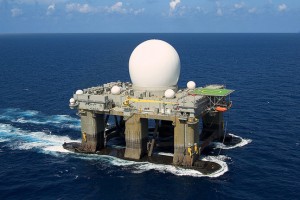Well, not really. But if you took to heart the headlines and the fear mongering press about North Korea’s announced missile launch, you might have concluded that North Koreans were just monsters bent on obliterating Hawai’i. The recent announcement by Sec. of Defense Gates that missile defense systems would be deployed to Hawai’i to protect against a North Korean missile launch is more propaganda to demonize and isolate North Korea while inciting fear to generate support for the extremely expensive and ineffective missile defense programs.
Hawaii anti-missile directive a safeguard
By Associated Press
POSTED: 11:07 a.m. HST, Jun 19, 2009
WASHINGTON >> A new anti-missile system ordered for Hawaii is partly a strategy to deter North Korea from test-firing a long-range missile across the Pacific and partly a precaution against the unpredictable regime, military officials said today.
The United States has no indication that North Korean missile technology has improved markedly since past failed launches, and military and other assessments suggest the communist nation probably could not hit the westernmost U.S. state if it tried, officials said.
The North’s Taepodong-2 could travel that far in theory, if it works as designed. But three test launches have either failed or do not demonstrate anything close to that range.
Nonetheless, past failure should not be considered a predictor, one military official said, and the seaborne radar and land-based interceptors were added this week as a prudent backstop.
Military and other U.S. officials spoke on condition of anonymity t o discuss the U.S. response a day after Defense Secretary Robert Gates said he is concerned about the potential for a North Korean missile launch toward Hawaii.
A senior defense official would not discuss details of range estimates for North Koreans missiles, but said the same principle of caution for Hawaii would apply if the North appeared to threaten U.S. territories in the Pacific.
Japanese media have reported the North Koreans appear to be preparing for a long-range test near July 4. The Daily Yomiuri reported that Japan’s Defense Ministry believes a long-range missile was delivered to the new Dongchang-ni launch site on North Korea’s west coast on May 30.
U.S. analysts say that after the last test fizzled, the North wants to prove its missile capability both as proof of military strength and as a sales tool for its lucrative overseas weapons deals.
A U.S. counterproliferation official said the U.S. government is not currently seeing preparations for launch of a long-range Taepodong-2 missile, sometimes short-handed as a TD-2. The official said a launch sometime in the future could not be ruled out but it is too soon to be seeing ground preparations for a launch around July 4.
“I don’t see any evidence that Hawaii is in more danger now than before the last TD-2 launch,” said Jeffrey Lewis, director of the Nuclear Strategy and Nonproliferation Initiative at the New America Foundation.
It took North Korea about 12 days to complete ground preparations before the April launch of a Taepodong-2, roughly equivalent to a U.S. Titan missile.
If North Korea does launch a long-range missile from its new Dongchang-ni site on the west coast, it could be placed on a southeast trajectory toward Hawaii.
However, the only three long-range missiles fired by North Korea so far have fallen well short of the 4,500 miles required to reach the chain of islands.
The North Korea missile launched in Apr il traveled just under 2,000 miles before falling into the Pacific. That was about double the distance traveled by a similar missile launched in 1998. North Korea also launched a missile in 2006 but it fizzled shortly after take off.
WASHINGTON >> A new anti-missile system ordered for Hawaii is partly a strategy to deter North Korea from test-firing a long-range missile across the Pacific and partly a precaution against the unpredictable regime, military officials said today.
The United States has no indication that North Korean missile technology has improved markedly since past failed launches, and military and other assessments suggest the communist nation probably could not hit the westernmost U.S. state if it tried, officials said.
The North’s Taepodong-2 could travel that far in theory, if it works as designed. But three test launches have either failed or do not demonstrate anything close to that range.
Nonetheless, past failure should not be considered a predictor, one military official said, and the seaborne radar and land-based interceptors were added this week as a prudent backstop.
Military and other U.S. officials spoke on condition of anonymity t o discuss the U.S. response a day after Defense Secretary Robert Gates said he is concerned about the potential for a North Korean missile launch toward Hawaii.
A senior defense official would not discuss details of range estimates for North Koreans missiles, but said the same principle of caution for Hawaii would apply if the North appeared to threaten U.S. territories in the Pacific.
Japanese media have reported the North Koreans appear to be preparing for a long-range test near July 4. The Daily Yomiuri reported that Japan’s Defense Ministry believes a long-range missile was delivered to the new Dongchang-ni launch site on North Korea’s west coast on May 30.
U.S. analysts say that after the last test fizzled, the North wants to prove its missile capability both as proof of military strength and as a sales tool for its lucrative overseas weapons deals.
A U.S. counterproliferation official said the U.S. government is not currently seeing preparations for launch of a long-range Taepodong-2 missile, sometimes short-handed as a TD-2. The official said a launch sometime in the future could not be ruled out but it is too soon to be seeing ground preparations for a launch around July 4.
“I don’t see any evidence that Hawaii is in more danger now than before the last TD-2 launch,” said Jeffrey Lewis, director of the Nuclear Strategy and Nonproliferation Initiative at the New America Foundation.
It took North Korea about 12 days to complete ground preparations before the April launch of a Taepodong-2, roughly equivalent to a U.S. Titan missile.
If North Korea does launch a long-range missile from its new Dongchang-ni site on the west coast, it could be placed on a southeast trajectory toward Hawaii.
However, the only three long-range missiles fired by North Korea so far have fallen well short of the 4,500 miles required to reach the chain of islands.
The North Korea missile launched in Apr il traveled just under 2,000 miles before falling into the Pacific. That was about double the distance traveled by a similar missile launched in 1998. North Korea also launched a missile in 2006 but it fizzled shortly after take off.
Source: http://www.starbulletin.com/news/breaking/48630442.html








